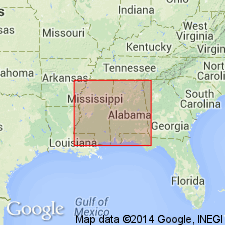
- Usage in publication:
-
- Chalybeate limestone member*
- Modifications:
-
- Named
- Dominant lithology:
-
- Limestone
- Marl
- Shale
- Sand
- Siltstone
- AAPG geologic province:
-
- Upper Mississippi embayment
Summary:
Named as member of Clayton formation. Named for town of Chalybeate, Tippah Co., northern MS. Occurs in northern MS and in AL west of Tombigbee River. Consists of hard crystalline, extremely fossiliferous limestone, interbedded soft to tough marls, dark leaf-bearing shales, glauconitic sand, and fossiliferous siltstone at top. Thickness at type locality is about 80 ft; thins southward to less than 10 ft in Clay Co., MS; from there southeastward, thickens to about 25 ft. Age is Paleocene. Reports of Mississippi Geological Survey for Tippah, Union, and Pontotoc Cos. divided Clayton into two unnamed members: a basal limestone and marl member, and an upper marl, clay, and sand member. Highest fossiliferous siltstone here included in Chalybeate member was regarded as base of Porters Creek clay in MS reports. This siltstone is here included in Clayton formation in order to make the clay the base of the Porters Creek throughout MS. Chalybeate may include equivalents of only the lower beds of Pine Barren member.
Source: GNU records (USGS DDS-6; Reston GNULEX).
For more information, please contact Nancy Stamm, Geologic Names Committee Secretary.
Asterisk (*) indicates published by U.S. Geological Survey authors.
"No current usage" (†) implies that a name has been abandoned or has fallen into disuse. Former usage and, if known, replacement name given in parentheses ( ).
Slash (/) indicates name conflicts with nomenclatural guidelines (CSN, 1933; ACSN, 1961, 1970; NACSN, 1983, 2005, 2021). May be explained within brackets ([ ]).

